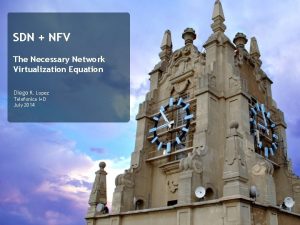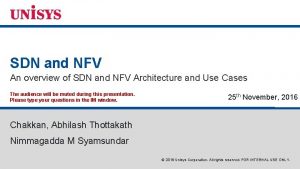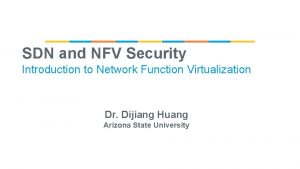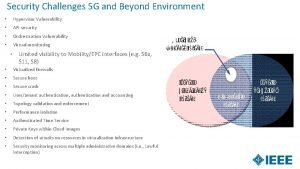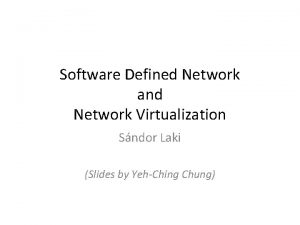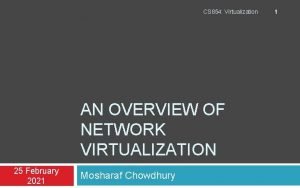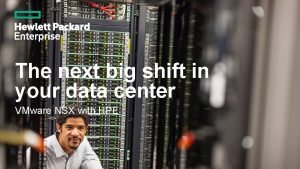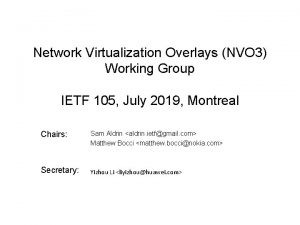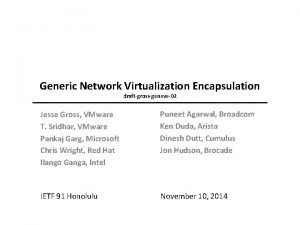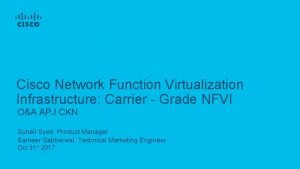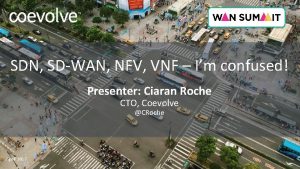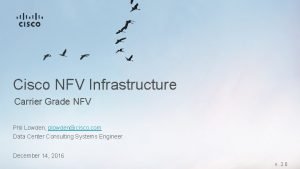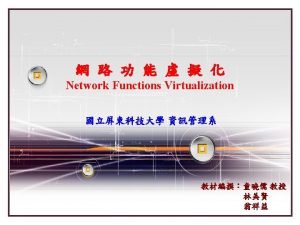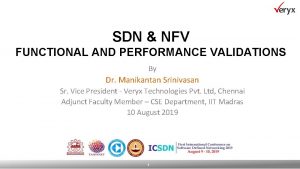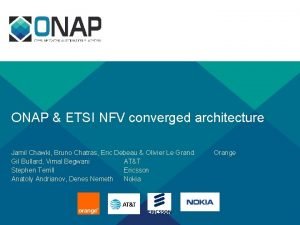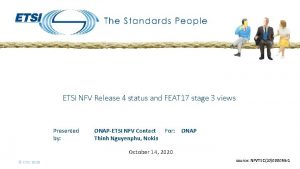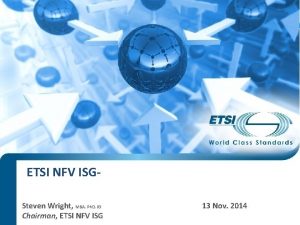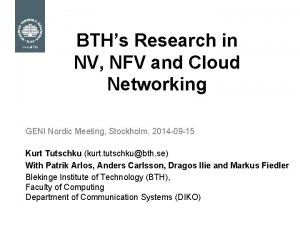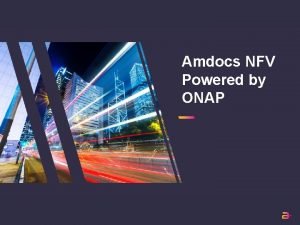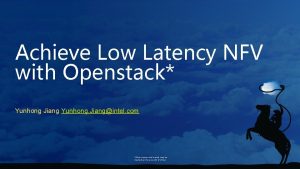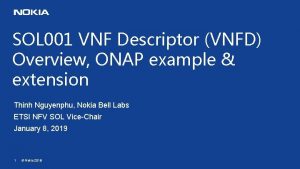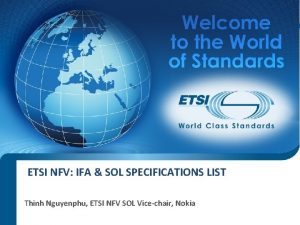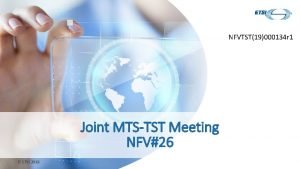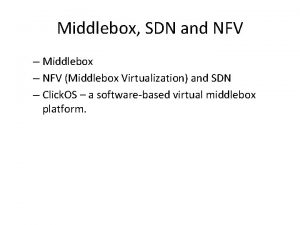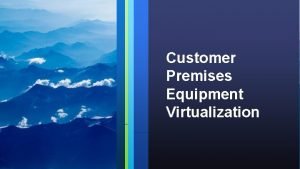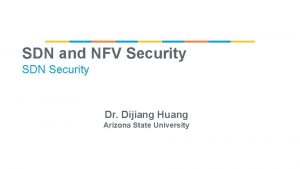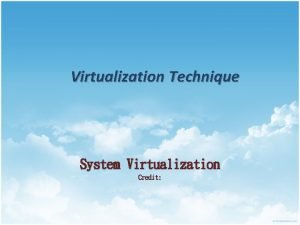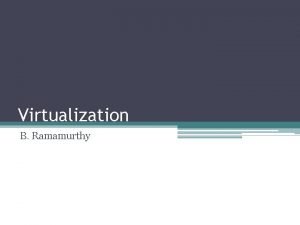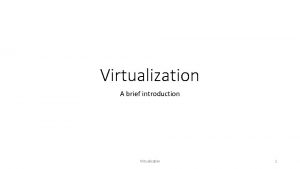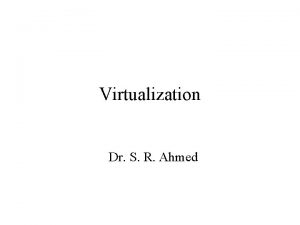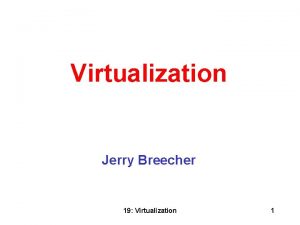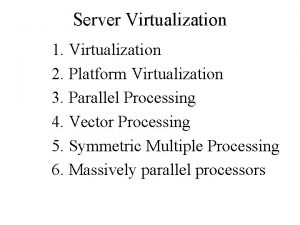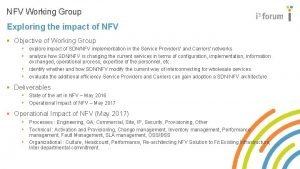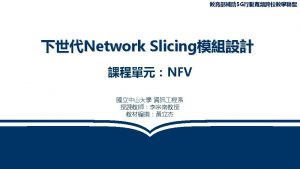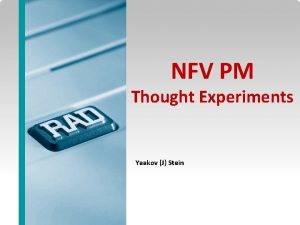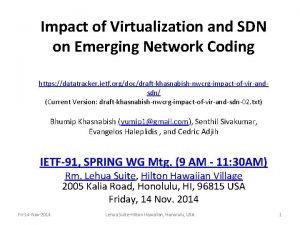SDN NFV The Necessary Network Virtualization Equation Diego





























- Slides: 29

SDN + NFV The Necessary Network Virtualization Equation Diego R. Lopez Telefonica I+D July 2014

Enter the Software Era Telco players • Very intensive in hardware • Capital intensive • Software is not at the core + HARDWARE Internet players x • Very intensive in software • Can have global impact with not too much capital • Hardware is a support, and is located in the network periphery SOFTWARE + - Network Virtualization takes the “Software-defined” as a key tool for transforming the industry

The Network Dystopia… Segmented management: High OPEX, often with low utilization of resources, high complexity, and slow time-tomarket for deploying any kind of network service…

…Makes IT Nonsense Mapping to computers how networks have evolved…

The Key Role of Virtualization A layered model virtualizing devices and resources

Scale and Virtualization in the Timeline Early twentieth century • • • Manual Switching Very intensive in human tesources Era dominated by hardware Mid-twentieth century x • • • Electromechanical Switching Less intensive in human resources Era dominated by complex hardware Virtualization technologies enables overcoming physical constraints and generating multiplexing gains… x • • Digital Switching Much less intensive in human resources Era dominated by complex and specific hardware. Software appears and is important Services defined by telco Second half of the twentieth century x • • Internet connectivity opens the door to the development of OTT services (without operator) Software becomes a differentiation asset Early twenty-first century

Network Virtualization = SDN + NFV • Provide a general interface to • network resources § Abstracting actual infrastructure details Decouple the planes conforming the network § Relying on software mechanisms to support functionality • SDN Decouple the control and data planes § Gain programmability § Simplify data plane elements Software in the network • NFV Separate functionality from capacity § Increase network elasticity § Reduce heterogeneity The network in software

Software Defined Networking SDN Open interfaces (Open. Flow) for instructing the boxes what to do Network equipment as Black boxes FEATURE OPERATING SYSTEM FEATURE SPECIALIZED PACKET FORWARDING HARDWARE FEATURE OPERATING SYSTEM SPECIALIZED PACKET FORWARDING HARDWARE FEATURE OPERATING SYSTEM SPECIALIZED PACKET FORWARDING HARDWARE SDN Boxes with autonomous behaviour FEATURE OPERATING SYSTEM FEATURE SPECIALIZED PACKET FORWARDING HARDWARE OPERATING SYSTEM SPECIALIZED PACKET FORWARDING HARDWARE FEATURE OPERATING SYSTEM FEATURE Decisions are taken out of the box SDN SPECIALIZED PACKET FORWARDING HARDWARE OPERATING SYSTEM SPECIALIZED PACKET FORWARDING HARDWARE Adapting OSS to manage black boxes Simpler OSS to manage the SDN controller

Make the Network *A* Computer • We can apply software • SDN Controller development techniques and tools Software development and operation being multifaceted § Different tools for different tasks • Static and dynamic verification • Translation: assemblers, compilers, interpreters, linkers • Testing and debugging • Version and configuration control • Dynamic composition and linking • Development flows • And any other abstraction capability SDN Forwarder OVS OVS

… OSS Bo. D DC Orchestrator • Applications use SDN to learn about the network • And then talk to the network to optimize performance • SDN acts in a similar way to an ESB CDN Network Brokering (or CORBA, for the old-timers) § An adaptor to go from protocols to APIs and vice versa § A translator, which summarizes network properties § A security/policy gateway that enforces which application is allowed to learn what and change what, and who gets priority ALTO Server OFC Network Elements . . .

Network OS • Providing a consistent interface to control, data and management plane § A layered model § The first take could follow an analogy with existing OS • The kernel is realized by control plane mechanisms • Data plane is associated with the file system • The management plane is mapped to the system tools § Remember the shell • Specific services to enforce policy and security • And the APIs

The Road to a Network IDE • The natural consequence of • applying concepts and tools related to software development Supporting a complete design flow § High-level definition and manipulation § Validation from simulation to actual debugging § Beta versions by slicing § Phased deployment § Integrate virtualized and nonvirtualized functional elements § Aligned with parallel IT development

Putting It All Together: The Net. OS Architecture v. Router v. Switch TE SDN App Topology IDE … NFV Orchestrator User Space (/usr) Northbound Interface SDN Apps Libraries Services App Execution Environment(s) Dist IF Virtual Network Layer Security / Accounting / Namespaces Distributed OS / State Consistency Network Abstraction Layer (NAL) Open. Flow VNF Net. Conf Network Elements I 2 RS Kernel (/kernel) Common Representation Model Security and Ancillary Services Namespaces and Module Management Devices and Drivers (/dev) Southbound Interface NAL Drivers

Network Functions Virtualisation A means to make the network more flexible and simple by minimising dependence on HW constraints v v Traditional Network Model: APPLIANCE APPROACH Virtualised Network Model: VIRTUAL APPLIANCE APPROACH DPI CG-NAT BRAS GGSN/ SGSN Firewall PE Router DPI BRAS GGSN/SGSN ORCHESTRATED, AUTOMATIC & REMOTE INSTALL PE Router Firewall CG-NAT VIRTUAL APPLIANCES Session Border Controller § Network Functions are based on specific HW&SW § One physical node per role STANDARD HIGH VOLUME SERVERS § Network Functions are SW-based over well-known HW § Multiple roles over same HW

The NFV Concept Network functions are fully defined by SW, minimising dependence on HW constraints DPI BRAS GGSN/ SGSN CG-NAT Firewall PE Router VIRTUAL NETWORK FUNCTIONS FUNCTION COMMON HW (Servers & Switches) CAPACITY

The ETSI NFV ISG • • • Global operators-led Industry Specification Group (ISG) under the auspices of ETSI • >200 member organisations Open membership • • • ETSI members sign the “Member Agreement” Non-ETSI members sign the “Participant Agreement” Opening up to academia Operates by consensus • Formal voting only when required Deliverables: Specifications addressing challenges and operator requirements • As inputs to SDOs Currently, four WGs and two EGs • • • Infrastructure Software Architecture Management & Orchestration Reliability & Availability Performance & Portability Security

The NFV ISG in Numbers • Growing membership and activitiy • • § 207 Member companies, (85 ETSI Members, 128 Participant Members) § 1095 people subscribed to the principal NFV mailing list § 15 active Work Items And results § Published 4 framework documents - Use Cases, Requirements, E 2 E Architecture and Terminology § 4 stable drafts available on the Open area § Created easy to navigate websites for access to public material § 18 accepted Po. Cs Planning a second phase © 17 ETSI 2014. All rights reserved

Service-Oriented Use Cases • • • Mobile core network and IMS § § Mobile base stations § § • Evolved Cloud-RAN Enabler for SON Home environment § § • Elastic, scalable, more resilient EPC Specially suitable for a phased approach L 2 visibility to the home network Smooth introduction of residential services CDNs § § Better adaptability to traffic surges New collaborative service models Fixed access network § § Offload computational intensive optimization Enable on-demand access services

The NFV Framework End Point E 2 E Network Service Logical Abstractions VNF Logical Links End Point VNF VNF Instances SW Instances VNF VNF VNF : Virtualized Network Function NFV Infrastructure Virtual Resources Virtual Compute Virtual Network Virtualization Layer Virtualization SW HW Resources Virtual Storage Compute Storage Network

The NFV Reference Architecture Os-Ma OSS/BSS Orchestrator Se-Ma Service, VNF and Infrastructure Description EMS 1 EMS 2 EMS 3 VNF 1 VNF 2 VNF 3 Or-Vnfm Ve-Vnfm VNF Manager(s) Or-Vi Vn-Nf NFVI Virtual Storage Virtual Computing Vi-Vnfm Virtual Network Nf-Vi Virtualization Layer Vl-Ha Computing Hardware Storage Hardware Execution reference points Hardware resources Network Hardware Other reference points Virtualized Infrastructure Manager(s) Main NFV reference points

Architectural Use Cases • Network Functions Virtualisation Infrastructure as a Service § Network functions go to the cloud • Virtual Network Function as a Service § Ubiquitous, delocalized network functions • Virtual Network Platform as a Service § Applying multi-tenancy at the VNF level • VNF Forwarding Graphs § Building E 2 E services by composition

The New Roles - Xaa. S for Network Services User NSP VNF Forwarding Graph VNF VNFaa. S Admin User VNF Admin User VNPaa. S VNF Hosting Service Provider VNF VNF VNF Tenants NFVIaa. S NFVI Provider Iaa. S Naa. S Paa. S Saa. S

It Ain’t Cloud Applied to Carriers The network differs from the computing environment in 2 key factors… 1 2 Data plane workloads (which are huge!) Network requires shape (+ E 2 E interconnection) HIGH PRESSURE ON PERFORMANCE GLOBAL NETWORK VIEW IS REQUIRED FOR MANAGEMENT …which are big challenges for vanilla cloud computing. AN ADAPTED VIRTUALIZATION ENVIRONMENT IS NEEDED TO OBTAIN CARRIER-CLASS BEHAVIOUR

A Proper Balance between NFV & SDN Service-layer SDN Simplify management, closing the gap between business logic and operation NFV § § Pool admin Session UPn. P mgmt IPv 4 / IPv 6 TR-069 DHCP Separation of HW and SW No vertical integration - HW vendor ≠ SW vendor ≠ Mgmt vendor § Once network elements are SW-based, HW can be managed as a pool of resources NAT ctrl. Infrastructural SDN Virtual backplane § Separation of control and data plane § Easy orchestration with SW domain

An Evolutionary Approach • NFV and SDN imply a significant change for current network infrastructures § No zero-day approach is feasible § Avoiding disruptions • Identify relevant use cases § Emerging services § Reuse of equipment still in amortization § Leverage on new planned elements in architecture Soft-Node • Plan for phased deployments § Interworking with existing infrastructure § Not breaking current operational practice • Take advantage of virtualization advantages § Flexibility § Extensibility § Reusability DS v. CPE

Current Targets: Virtual Residential CPE Shifting network functions deployed in home environment to the network… Telco Network environment Home environment Access Point Switch Módem STB Virtual CPE UPn. P IPv 4/IPv 6 TR-069 DHCP • • Simple, stable along the time and cheaper customer premises equipment Quick and transparent migration to IPv 6 • • • FW NAT Service evolution and operation is supported inside telco network Monetize cloud and video services (virtual set top box) Monetize security and digital identity features Live trial today MATURITY LEVEL Commercial before end 2014 EXPLORE Po. C TRIAL DEPLOY

Current Targets: Elastic DPI CENTRALISED INTELLIGENCE Other data Deeper Network Big Data RELEVANT INFO Copy REAL-TIME ANALYSIS Metadata interface Security Alarms Open. Flow RAW USER TRAFFIC NFV domain x. DRs POLICY DECISIONS MITIGATION SDN domain OF Controller OF Switch • >80 Gbps line rate per server • Stable signatures • Flexible data analysis and signature upgrade • Forensic analysis feasible. MATURITY LEVEL EXPLORE Po. C TRIAL DEPLOY

Current Targets: Enhanced Virtual Router Leverage on open source routing project (Quagga) as rich and widely tested protocol suite while assuring data plane performance OPEN-SOURCE CONTROL PLANE (Quagga + Linux) • Common routing protocols supported and extended by open source project. • Well-known router command line. OPTIMIZED DATA PLANE (DPDK-based) • High-performance line-rate data plane. • Running as separate process, does not lead to licensing issues. MATURITY LEVEL EXPLORE Po. C TRIAL DEPLOY

Counting a Few • • Orchestration has the key § § Pieces at all infrastructure layers Need to go beyond just fitting them together Big data in the loop Seize the opportunity to simplify systems and processes Identify interstitial security threats § § § Topologies Trusted boot Several identity layers and accounting Design patterns § § § Big multi-user VMs vs small single-user ones Componentization Building services by composition Dealing with topology layers § § Up to three: infrastructural, virtualized, and service Mapping to current practices and protocols
 Which application
Which application Nfv vs sdn
Nfv vs sdn Nfv&sdn
Nfv&sdn Mef sdn
Mef sdn Sdn nfv
Sdn nfv Sdn architecture vs traditional network
Sdn architecture vs traditional network Finger network sdn bhd
Finger network sdn bhd Flowvisor
Flowvisor Cs 854
Cs 854 What is off box network virtualization
What is off box network virtualization Hpe network virtualization
Hpe network virtualization Nvo agenda
Nvo agenda Chris wright red hat
Chris wright red hat Cisco nfvi architecture
Cisco nfvi architecture Sdwan
Sdwan Www.etsi.org
Www.etsi.org Cisco nfv solution
Cisco nfv solution Nfv 介紹
Nfv 介紹 Nfv
Nfv Nfv
Nfv Etsi nfv release 4
Etsi nfv release 4 Nfv jd
Nfv jd Nfv
Nfv Ecomp nfv
Ecomp nfv Nfv
Nfv Sol001
Sol001 Etsi nfv sol 001
Etsi nfv sol 001 Mika jungclaus
Mika jungclaus Etsi gs nfv-ifa 011
Etsi gs nfv-ifa 011 Nfv router
Nfv router
